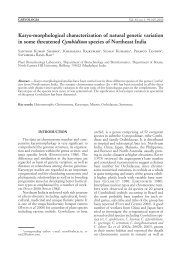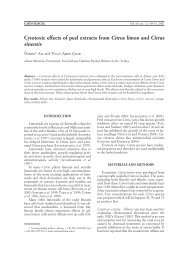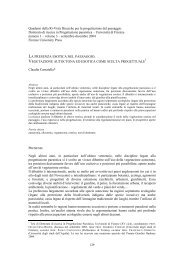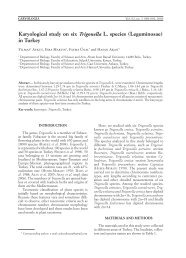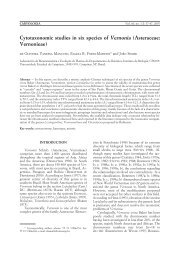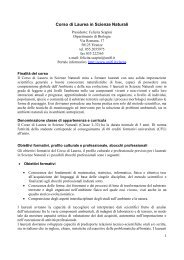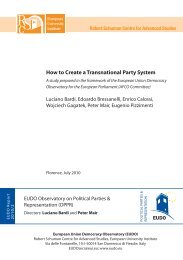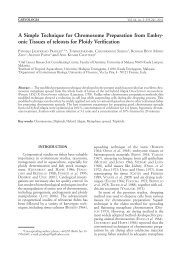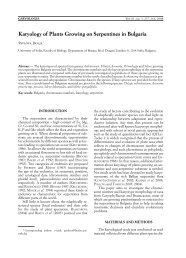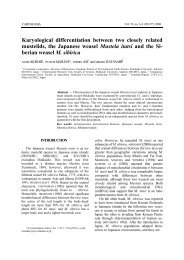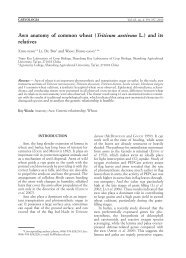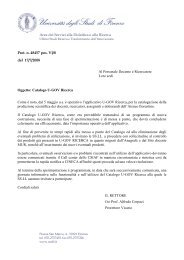A revised cytotaxonomy of the genus Tulbaghia (Alliaceae)
A revised cytotaxonomy of the genus Tulbaghia (Alliaceae)
A revised cytotaxonomy of the genus Tulbaghia (Alliaceae)
Create successful ePaper yourself
Turn your PDF publications into a flip-book with our unique Google optimized e-Paper software.
94 VOSA<br />
13. <strong>Tulbaghia</strong> leucantha Baker, Flora Capensis,<br />
6:404 (1897); Uph<strong>of</strong>, Herbertia, 10: 47 (1943); Vosa,<br />
Ann. Bot. (Rome), 34: 96-99) (1975).<br />
SYNTYPES — NATAL. - Near <strong>the</strong> river Tugela,<br />
Medley Wood 4408 (K!). CAPE. - Zuurberg (Griqualand<br />
East), MacOwen 1208) (K!).<br />
SYNONYMS — <strong>Tulbaghia</strong> dieterlenii Phillips, Ann. S.<br />
Afr. Museum 16: 300 (1917), type: Leribe (Lesotho),<br />
Dieterlen 361 (BM).<br />
<strong>Tulbaghia</strong> friesii Suesseng, Trans. Rhodes Sci<br />
Ass. 43: 76 (1957).<br />
<strong>Tulbaghia</strong> rhodesica Weimark, Bot. Not. 90: 169<br />
(1937) nom. illeg.<br />
ICONOGRAPHY — (Vosa, 1975, fig. 15, Plate XIII, fig.<br />
3); Plate IIIB.<br />
CHROMOSOME NUMBERS — 2n=2x-12; 2n=4x=24<br />
(karyotype D, fig. 13).<br />
DISTRIBUTION — The diploid forms occur from <strong>the</strong><br />
NE Cape, Lesotho to <strong>the</strong> N Transvaal while <strong>the</strong><br />
tetraploids occur from N Transvaal to Swaziland and<br />
Zimbabwe. In <strong>the</strong> Transvaal, from around Warmbad<br />
and Pietersburg and <strong>the</strong> Kruger Park, <strong>the</strong>re seems to<br />
be an overlap between <strong>the</strong> two forms.<br />
EXSICCATA — Diploids: TRANSVAAL. - 2430<br />
(Pilgrim's Rest): Blyde's River Canyon at 'One Mile<br />
Walk', in short turf among large rocks, Vosa 54/1<br />
(OXF); - 2528 (Pretoria): among rocks near Warmbad,<br />
De Wet 3799 (PRE); in acid, peaty vlei near <strong>the</strong><br />
roadside at Delmas, Vosa 430/35 (OXF); Between<br />
Kestell and Bethlehem by <strong>the</strong> Eland's Bridge, Vosa<br />
1704 (OXF); on rocks in shallow soil by <strong>the</strong> road<br />
from Maseru to Ladibrand, Vosa 1711 (OXF).<br />
Tetraploids: ZIMBABWE. - 1731 (Harare):<br />
Groombdrige, H.M. Eiegel 2860 (SRGH); TRANS-<br />
VAAL. - 2431 (Acornhoek): in dry sandy soil in open<br />
woodland, 10 km N <strong>of</strong> Skukuza, Vosa 449/38<br />
(OXF).<br />
O<strong>the</strong>r exsiccata: TRANSVAAL. - 2528 (Pretoria):<br />
Delmas Road, Codd 2182 (PRE); 10 km W <strong>of</strong><br />
Hammanskraal, Leach 10659 (PRE). SWAZILAND. -<br />
2531 (Mbabane): near Bulunga Poort, Manzini,<br />
Compton 31754 (NBG). ORANGE FREE STATE. -<br />
2828 (Bethlehem): Hoogland, Liebenberg 7291<br />
(PRE). CAPE. - 3028 (Matatiele): Mt. Fletcher, Killick<br />
& Marais 2076 (PRE). NATAL. - 3029 (Zuurberg):<br />
MacOwen & Bolus (1208) (K); Medley Wood<br />
1200 (K).<br />
VERNACULAR NAMES — Sou<strong>the</strong>rn Sotho: leta la ph<strong>of</strong>u.<br />
<strong>Tulbaghia</strong> leucantha is found widespread from<br />
<strong>the</strong> N E Cape to N Transvaal, Swaziland and Zimba-<br />
bwe. It is very variable even within <strong>the</strong> same population<br />
in <strong>the</strong> size <strong>of</strong> <strong>the</strong> flowers, in <strong>the</strong> colour <strong>of</strong> <strong>the</strong> corona<br />
and in <strong>the</strong> leaves which can vary from very this<br />
and grass-like to 5-8 mm broad. Overall, <strong>the</strong> proportion<br />
<strong>of</strong> thin-leaved plants, in a given population, seems to<br />
increase with altitude. The tetraploid forms are much<br />
less variable than <strong>the</strong> diploids but on <strong>the</strong> whole <strong>the</strong>y<br />
have slightly larger flowers. In any case, most <strong>of</strong> <strong>the</strong><br />
o<strong>the</strong>r characters in both forms, overlap in such a way<br />
that it is not possible to distinguish <strong>the</strong>m with certainty<br />
in <strong>the</strong> field, or in herbarium specimens.<br />
The morphological variability <strong>of</strong> <strong>Tulbaghia</strong> leucantha<br />
over its considerable range, has resulted in <strong>the</strong> description<br />
<strong>of</strong> new species, mainly based on herbarium<br />
specimens, by various authors. However, all <strong>the</strong> forms <strong>of</strong><br />
<strong>the</strong> species have a very uniform karyotype and are<br />
interfertile. In any case, <strong>the</strong> epi<strong>the</strong>t T. leucantha, used<br />
by Baker in 1896, has priority over T. dieterlenii Philips<br />
(1917) and over T. friesii Suesseng (1957).<br />
The name T. rhodesica Weimark (1937), cited as a<br />
synonym <strong>of</strong> T. leucantha, is illegitimate because it has<br />
been already used for a very different species (T.<br />
rhodesica R.E. Fries, 1916).<br />
Fig. 13 — <strong>Tulbaghia</strong> leucantha (2x), karyotype D. Note <strong>the</strong><br />
small satellite intercalary to one <strong>of</strong> <strong>the</strong> nucleolar organizer<br />
thread (double arrow).




